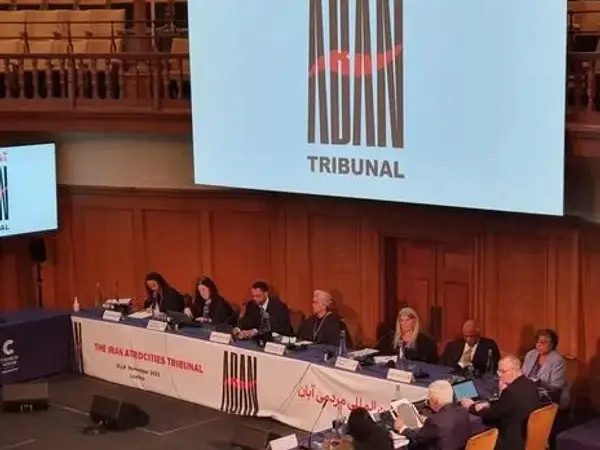The second day of the ‘Iran Atrocities Tribunal’ continued Thursday with oral testimonies from anonymous witnesses, including a former police officer and two protesters.
The tribunal, which styles itself a “Russell tribunal” after the late British philosopher Bertrand Russell, convened in London Wednesday to examine the atrocities of violence against protesters in Iran in November 2019. Iran declined an invitation from the organizers to take part.
Social media traffic showed great interest among Iranians in following the proceedings and posting comments.
‘Witness 195,’ who said he was a former major in the Iranian police, testified via video-link disguising his voice to protect his identity, that he had refused a command from an officer in the Revolutionary Guards (IRGC) to deploy his 60 officers to suppress the protests in a city in the west of Iran. He said he had told the police under his command they had “no right to use firearms against unarmed protesters.”
Witness 195 claimed he had seen "plainclothes agents of the IRGC and intelligence ministry spraying the protesters with bullets,” killing 15 on November 19. "Armed [agents] shot at protesters with no purpose other than intimidating them," he said. The witness said that the security forces had destroyed public property and blamed protestors.
Witness 195 said he was arrested a few months later for disobeying an order to shoot at the protesters, held in solitary confinement and subjected to psychological torture. He said he had been sentenced to nearly six years in prison but that the sentence had not been enforced.
‘Witness 128’ testified in person that he had witnessed the killing of two protesters in the southeastern province of Sistan-Baluchestan.
After the tribunal was shown video footage of protests on a road leading to Rask, a city of Sistan-Baluchestan, witness 128 said he had seen IRGC forces 200 meters from where the film was taken, and claimed they had shot at protesters from nearby villages trying to reach Rask by the road.
‘Witness 366,’ testifying via videoconference, displayed an x-ray, which he said was of his chest and showed a bullet, lodged in his spine on November 16, 2019, that had put him in a wheelchair. Witness 366 told the tribunal he was certain he had been shot by security forces and not by armed protestors.
The tribunal on Thursday also heard Raha Bahraini, a researcher at Amnesty International, report that many arrested protesters, including children, had been sexually assaulted, raped, or tortured by hanging and staged executions.
"This people's tribunal is very important," Bahraini told Iran International. "It's a strong initiative against the continued impunity for crimes in Iran," she said. Bahraini said there was no chance of justice through the Iranian judicial system so responsibility fell on the United Nation's Human Rights Council and the United Nations Security Council to bring those responsible for the “atrocities” to justice.
